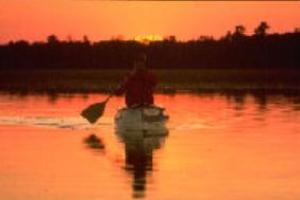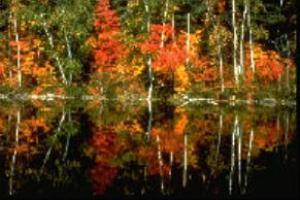
Waterfalls on the Clearwater River
Located in northwestern Saskatchewan approximately 500 kilometres from the city of Prince Albert, the Clearwater River is, as its name implies, an unspoiled, clear-water river in a pristine wilderness setting of spectacular beauty. Because of these qualities -- the outstanding significance of its natural heritage and historical features, and the fine opportunities it holds for recreation in the form of wilderness camping and canoeing - the Saskatchewan section of the Clearwater, from its headwaters in Lloyd Lake to the Alberta border, has become an important addition to the Canadian Heritage Rivers System. Although a road crosses the river at Warner Rapids, most of the river is very remote and access to the backcountry is limited to float-planes. It is this isolated wilderness character of Clearwater which is its major appeal.
Designated to the Canadian Heritage Rivers System in June, 1986, the Clearwater brings to the System geological formations representing two major periods in the earth's geological development; rare and endangered species of birds and animals; evidence, in the form of "pictographs" of the region's pre-European Indian occupation; and, the historic Methye Portage, over which passed many of Canada's early explorers and fur traders.

Waterfalls on the Clearwater River
In order to conserve the Clearwater's heritage value the province of Saskatchewan has established the Clearwater River Wilderness Park. This 200,000 hectares (780 square miles) park will protect the natural and historical heritage resources and the recreational opportunities for which the Clearwater was designated a Canadian Heritage River.
Rising in the northern coniferous forest region of the Precambrian Shield in northwestern Saskatchewan, the Clearwater flows southeast for roughly half of its 187 km course through Saskatchewan before turning sharply southwest. It continues 108 km beyond the Alberta border to join the Athabasca River at Fort McMurray. Its waters eventually reach the great Mackenzie River and the Arctic Ocean. From its headwaters in Broach Lake, just beyond Lloyd Lake at 460 m above sea level, the Clearwater drops about 150 m to its junction with the Athabasca. As it flows downstream, the river passes through two distinct geological areas, the character of the river changing to reflect the underlying changes in bedrock. The upper portion flows over the Precambrian Shield, through boulder strewn rapids, over rocky ledges and small waterfalls and through at least one sizeable gorge. Downstream, the river valley deepens as it enters the Interior Plains and meandering channels are characterized by sandbars and islands. High valley walls of Devonian limestone are seen as the river heads out into Alberta.

Scenic dolomite gorges characterize the lower Clearwater River
The region surrounding the Clearwater contains a diversity of natural features, some unique, and many providing excellent examples of particular landforms. The river's most spectacular feature is the broad, deep, glacial spillway in the river's lower reaches, but other interesting landforms include evidence of glacial drift along the valley corridor; where small gorges cut deeply into sedimentary rocks. Nearby are many eskers, kames and the huge Cree Lake Moraine. These and other geological features represent all major eras of the developmental history of our planet earth.
Quite a number of rare plant species may be found along the Clearwater, as well as rare and endangered wildlife species, notably bald eagles, osprey and white pelicans. Wolverine, increasingly rare now in Canada, and Woodland Caribou, have also been seen in the area.
Despite its wilderness state, the Clearwater is of national significance in terms of Canada's historical development, both before the time of European exploration and after. It is believed that archaeological excavation will someday reveal habitation of the area by aboriginal people as long as 5,000 years ago. Historical evidence now indicates Beaver Indians, as well as the Cree and Chipewyan. Three interesting and important rock-paintings or "pictographs" are located on the upper portion of the Clearwater between Lloyd and Careen Lakes. These paintings, reddish symbols and shapes on vertical rock surfaces, are the furthest north and west of all such sites documented to date in Saskatchewan.
In more recent times, during the period of European exploration and the 18th century fur trade, the Clearwater played a vital role in the development of the Canadian west by providing a major transportation link between Hudson's Bay and the Athabasca District. Both fur traders and explorers who included among their members such notables as David Thompson, Sir Alexander Mackenzie, Peter Pond, Sir John Franklin and Sir George Simpson took advantage of this relatively quick exploration and trade route to the west. A National Historic Site plaque commemorates the significant role played here by the Methye Portage, a 19 km overland link on the Churchill-Clearwater-Athabasca route between Lac La Loche and the Clearwater which was used to avoid the Clearwater's difficult Precambrian upper section. First used in 1778, Methye Portage provided the first major overland connection for what was to be the only route between east and west for almost 40 years. Even as other more southerly routes were developed, the Clearwater-Athabasca route continued in use well into the 18th century.
The Clearwater's greatest recreational value lies in the opportunity it provides for visitors to experience an extended wilderness canoe and camping trip through an area of unspoiled and outstanding natural beauty. Representing virtually every type of river condition ranging from challenging white-water rapids, narrow channels and gorges, to broad, meandering sections with islands and sandbars, this remote and wild river provides an excellent opportunity for experienced white-water adventurers to test their skills. In addition to the

Calm waters at sunset
exhilaration of tackling the river itself, wilderness canoeists will also find potential for wildlife photography, fishing, hiking, observing nature and appreciating Canada's history and prehistory. Fishing for walleye, arctic grayling and northern pike is popular among individual anglers and fishing parties using commercial fly-in fishing camps in the area. Hiking the Methye Portage from Lac La Loche is also becoming more popular.
Due to its undeveloped state, its large distance from major population centres, and its limited accessibility, the Clearwater River area offers little in the way of facilities, services and accommodation.
Access: Highways 155 and 955 (the Cluff Lake Road) provide road access to this part of northwestern Saskatchewan. River access is possible at the bridge crossing at Warner Rapids and via a short trail from Highway 955 into Lloyd Lake. But for most of those exploring Clearwater River backcountry, float-plane charters to fishing and hunting camps on lakes on or near the river are the preferred means of beginning or ending trips. Access to the river by water is also possible from the north end of Lac La Loche across the bay but this requires the strenuous, 19 km trek in the steps of the voyageurs over the Methye Portage.
Accommodation: Roadside camping is provided at a 20-site provincially operated campground near the bridge at Warner Rapids. Canoeists are presently permitted to camp at any suitable sites along the river. Accommodation may also be arranged at a commercial fishing lodge on Lloyd Lake and at several other fishing camps which altogether provide accommodation for about 50 people.
Canoeing: Because of its wild nature and relative inaccessibility, the Clearwater is recommended only to canoeists with skill and experience in whitewater canoeing. From Lloyd Lake to its confluence with the Athabasca River at Fort McMurray, the Clearwater provides approximately 295 km of canoeing with between 8 and 14 portages. The lower section of the river is the easiest to paddle, suitable for intermediate canoeists, but may only be reached via the Methye Portage.

Canoeing swift waters on the Clearwater River
Topographic Maps: The section of the Clearwater River designated to the Canadian Heritage Rivers System is covered at the 1:250,000 scale by four maps in the National Topographic Series: Mudjatik River (74 B), La Loche (74 C), Fort McMurray (74 D), and Lloyd Lake (74 F). These maps may be obtained from the Canada Map Office, 615 Booth Street, Ottawa, K1A 0E9 and from the Central Survey and Mapping Agency, Saskatchewan Property Management Corporation, 2nd Floor, 2045 Broad Street, Regina, Saskatchewan, S4P 3V7.
Clearwater River Wilderness Park Services, Permits and Regulations: Director, Parks, Department of Parks, Recreation and Culture, 3211 Albert Street, Regina, Saskatchewan, S4S 5W6.
Tourist Information: Tourism Saskatchewan, Bank of Montreal Building, 2103 11th Avenue, Regina, Saskatchewan, S4P 3V7.
Canadian Heritage Rivers System: Secretary, Canadian Heritage Rivers Board, Ottawa, Ontario, K1A 0M5
Additional Reading:

Autumn colours of the Canadian Shield
| More Information | Return to CHRS homepage | Table of Contents |
|---|